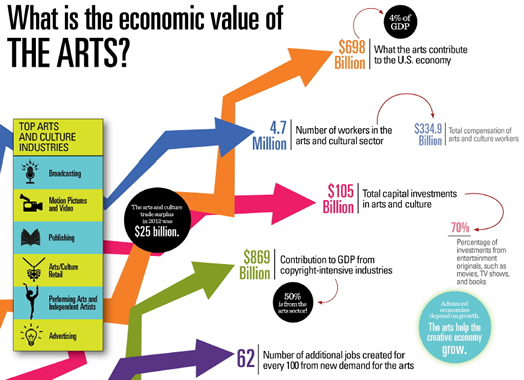Allegro
Investment in the arts doesn’t cost us money – it MAKES us money!
Volume 117, No. 5May, 2017

David Byrne. Photo: Catalina Kulczar
I just got back from a rally at City Hall. It was organized by City Council member Jimmy Van Bramer to protest the proposed budget cuts to both publicly funded arts organizations (NEA, NEH and the Corporation for Public Broadcasting) and the library system. Lots of other council members, museum directors, actors, union representatives and many more were on hand. It was a beautiful spring day. I spoke very briefly, making the economic and social argument that arts funding benefits the economy and creates jobs way in excess of the amount invested. It has the effect of lowering crime, raising property values and lowering child abuse! Really!
The Trump administration and their Republican allies hope to eliminate funding for a number of federal arts organizations. This is a political move – it really doesn’t amount to much money – it’s a tiny part of the federal budget. The amount of federal funding is $741 million, which sounds like a lot, but is less than one-tenth of 1 percent of the United States’ annual federal spending, an amount supporters say is too small to make a difference in the budget if it was cut. On a budget pie chart it doesn’t even show up, it’s too small.
Q: What does that “investment” get us as a nation?
A: It gets multiplied more than 100 times = $135.2 billion.
The arts are considered superfluous by many, and fluffy and indulgent by others. Plays and projects that appear ridiculous are often held up as examples of “look where your tax dollars are going.” The arts are often viewed as the provenance of the elites – “Why should we be paying for the silly amusements of other people? Stuff we have no interest in?”
Well, my argument to those skeptics has nothing to do with the quality of the artworks. I might actually agree that some of it is indulgent and silly, but I would argue that there is undeniable and indisputable monetary and social value to the nation as a whole in the publicly-funded arts. It is by far one of the best investments the government can make, and here’s why.
A recent study called Arts and Economic Prosperity found that nationally the nonprofit arts (we’re not talking about Broadway shows, pop concerts, video games, movies or the art world) generate $135.2 billion in economic activity in the U.S.
If one includes other kinds of for-profit arts organizations, the number jumps up, way up:
In 2013, the production of arts and cultural goods added more than $704 billion to the U.S. economy. This amounts to 4.23 percent of GDP. The arts and cultural sector contribute more to the national economy than do the construction, agriculture, mining, utilities, and travel and tourism sectors. Below is a graphic with a similar number.

CLICK IMAGE TO VIEW FULL SIZE PDF. The arts contribute a whopping $698 billion to the U.S. economy. Source: Nation Endowment of the Arts.
There’s a halo effect as well. The real estate value of homes and businesses increases significantly around cultural centers. Developers and real estate investors understand this. An arts or cultural center increases the value of their nearby properties. Businesses – restaurants, cafes, shops – around cultural centers do better when there is an arts center close to their business. The value of real estate around culture goes up.
These effects are not just in big cities and mainly for the elites that live in them – this funding goes to small organizations across the country – in thousands of small towns and communities. To both red and blue states – they all benefit.
And that’s not all – the arts also have positive effects on health, safety, education…and their presence lowers the crime and child abuse rate – all at bargain rates!
A study released this month by researchers from the School of Social Policy & Practice at the University of Pennsylvania has revealed a quantitative relationship between the presence of cultural resources in a neighborhood and key aspects of social well-being, particularly in under-served neighborhoods. In New York City, the relative higher presence of cultural resources in lower-income neighborhoods is linked with serious health, safety, and education benefits. These include a 14 percent decrease in indicted investigations of child abuse and neglect, an 18 percent decrease in the felony crime rate and also a 17 to 18 percent increase in the number of students scoring at the highest level on standardized math and English tests. Other ways of making these improvements in our communities are much more expensive – and often not as effective.
One can argue that placing these kinds of metrics on the arts is unfair – not everything that makes money is good and some of the best and most influential works fail or were badly received when they were made. True.
But even so.…why in the world would one want to walk away from such an incredible investment? It’s probably the best investment the government makes – as far as a means of generating jobs, growth and social good. Surely the businessmen and women in our government can see this and get beyond making silly political points at the expense of the nation, its economy and people.
David Byrne is a multi-media artist and a founding member of the Talking Heads. He has received Oscar, Grammy and Golden Globe awards and has been inducted into the Rock and Roll Hall of Fame. Byrne first joined Local 802 in 1999. This essay is reprinted with permission from www.davidbyrne.com/journal/what-good-are-the-arts
FOR MORE: Read Local 802 members’ reactions to the Save the Arts rally in the Musicians’ Voice.
